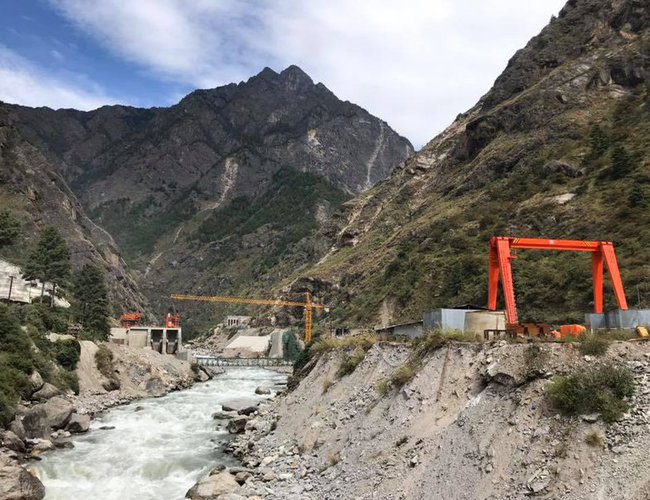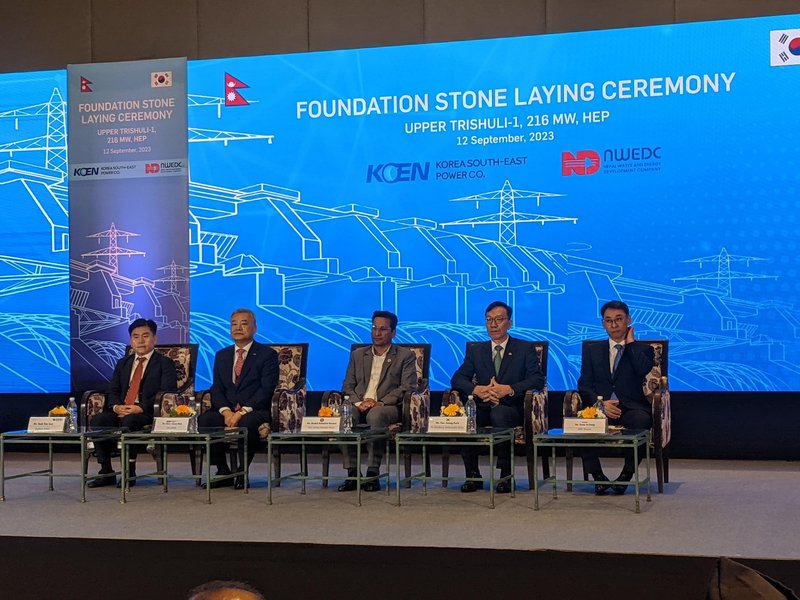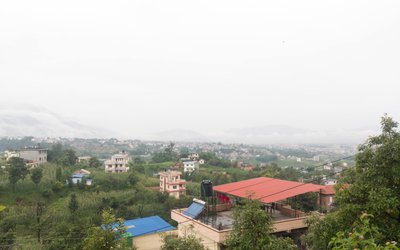
Minister of Energy, Water Resources and Irrigation Shakti Bahadur Basnet said that the government is creating an environment for domestic and foreign investment in this area to achieve economic prosperity through hydropower development in Nepal.

Addressing a he foundation stone laying ceremony of Upper Trishuli 1(UT-1) Hydropower Project, minister Basnet urged to complete the project in estimated time and assured the necessary coordination and facilitation.
He urged domestic and foreign investors to increase investment in the hydropower sector as the market for electric trade has been assured.
Minister Basnet said that the demand for electricity inside the country will be around 1,5000 MW within the next 12 years.
President and chief executive officer of Korea South-East Power (KOEN), Hoe-Chun Kim said that by using Nepal's vast water resources, increasing domestic consumption of clean green energy and exporting surplus electricity to neighbouring countries, it has made a great contribution to achieving economic prosperity and reducing the impact of climate change.
He said that the project is very important for fulfilling the increasing internal power demand especially in the dry season of Nepal and to decrease power import.
He said that they were committed to complete the construction of the UT-1 hydropower project within the stipulated time.
Ambassador of South Korea to Nepal Park Tae-Young expressed his belief that completion of the construction of the UT-1 will support in attracting foreign direct investment in Nepal.
Approximately 1000 workers work at the construction site, including about 500 local residents from project affected Rasuwa district.
During the construction period (five years) 700-1000 Nepali employees will work for the project. And 70-80 Nepali employees will work during the operation period (30 years).
The project's main construction started in January 2022 and is estimated to be completed in December 2026.
The main construction works including the excavation of the underground powerhouse, and headrace tunnel, head works are in full swing in all fronts and the overall progress rate of the project is 22 per cent.
The Koreans who came to Nepal with the agreement to invest in the UT-1 project in 2012 announced that the project would be completed in April 2019. But due to various reasons, Power Development Agreement (PDA) was done in 2016 and PPA was done with the project in 2018. In 2019, the financial management was completed.
Nepal Water and Energy Development Company (NWEDC), a special purpose vehicle through which Korea South-East Power Co. (KOEN) along with Korea Overseas Infrastructure and Urban Development Corporation (KIND), International Finance Corporation (IFC) a member of World Bank Group and domestic investor, is developing the project on build-own-operate-transfer (BOOT) basis, under a project development agreement signed with the government of Nepal in December 2016.
The UT-1 is the largest hydroelectric project under construction with foreign direct investment for domestic consumption. The concession period for the project is 35 years, including five years of construction period.
The USD 647.4 million (including interest during construction) project is financed through 70 per cent debt and 30 per cent equity.
The shareholders of NWEDC include KOEN, Korea Overseas Infrastructure and Urban Development Corporation (KIND), IFC, and a local Nepalese partner. In the future, the project affected communities will be given a chance to apply for 10 per cent shares of the project.
The project partners will provide an equity investment of USD 194.20 million. In comparison, the debt of USD 453.12 million is being provided by a group of international lenders, including IFC, ADB, Korean Exim Bank (K-EXIM), Korean Development Bank (KDB), Asian Infrastructure Investment Bank (AIIB), FMO (The Netherlands), the British International Investment (BII), Proparco (France), and the OPEC fund for International Development (OFID).
The UT-1 is expected to generate up to 1,533 GWh of electricity. Out of the total annual energy generated by the project, 38.75 per cent will be generated during the dry season, which is higher than most of the other run-of-the-river hydropower projects in Nepal, thus contributing significantly to managing the dry season electricity shortfall.
The project is very attractive for the country's power system as it is close to the Kathmandu load centre and will get 104 MW of electricity even in the dry season with high electricity demand.
The generated energy will flow to the national grid by connecting it to the Trishuli-3B hub substation the NEA is constructing.
The NEA will purchase the entire electricity output of Upper Trishuli-1, under a 30-year power purchase agreement (PPA) signed with NWEDC in January 2018.
- 139 People Died In The Disaster
- Jul 27, 2024
- Monetary Policy Eases Managing Capital Fund Stress
- Jul 27, 2024
- Weather Forecast: Chances Of Heavy Rainfall Is Likely In One Or Two Places Of Sudu Paschim And Bagmati Province
- Jul 27, 2024
- The Sentiment Of Monetary Policy Seems Focused On Increasing Eemand: FNCCI President Chandra Prasad Dhakal
- Jul 26, 2024
- Monetary Policy 081/82 Is Making The Economy More Dynamic: Governor Adhikari
- Jul 26, 2024
















